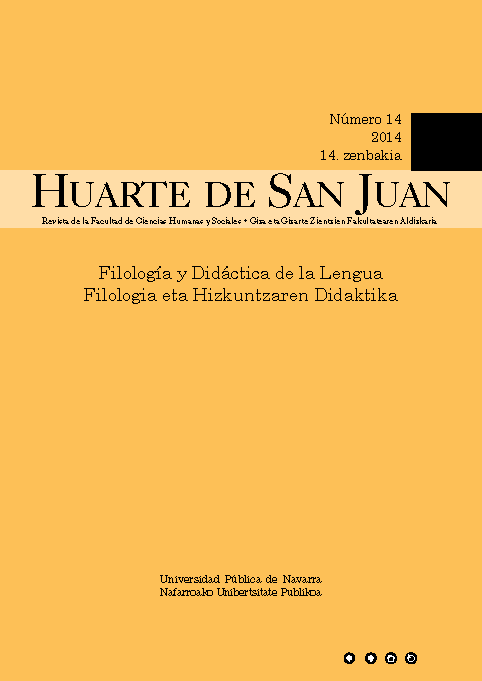Cortesía lingüística: un estudio en el ámbito educativo
Abstract
Although linguistic courtesy has been extensively investigated among adults, there is no research analysing it in education contexts. This study sets out to highlight the need of having to train secondary school learners in linguistic courtesy. Due to the lack of previous research, some role play activities were done in order to comprehend the situation of linguistic courtesy in the classroom. Students from compulsory and optional secondary education have carried out spontaneous conversations about four different situations. The study analysed the strategies they chose and the structures constructed. The findings revealed that girls and boys tend to choose different strategies and structures in order to face those situations. Furthermore, among teenagers differences are notable depending on their age. That is, it was found that both the sex and age of teenagers (evolutionary stage) are variables of linguistic courtesy.
Downloads
References
ALCARAZ y MARTÍNEZ (1997): Diccionario de Lingüística Moderna, Ariel.
ANASTASI, A. y FOLEY, J. P. (1958): Differential Psychology, New York, Macmillan.
BALLESTEROS MARTÍN, Francisco José (2003): «La cortesía verbal: análisis pragmático lingüístico de las exhortaciones impositivas en inglés y en español: el ruego y el mandato» (tesis doctoral), en pdf disponible en [http://biblioteca.ucm.es/tesis/19972000/H/3/H3052801.pdf] [consulta, 1 de marzo de 2014].
BRIGGS, C. L. (1986): Learning How to Ask: A Sociolinguistic Appraisal of the Role of the Interview in Social Science Research, Cambridge University Press.
BRIZENDINE, L. (2006): The female brain, Broadway Books.
BROWN, P. y LEVINSON, S. C. ([1978] 1987): Politeness: Some Universals in Language Usage, Cambridge University Press.
BUFFERY, A. W. H.; Gray, J. A.; Ounsted, C. y Taylor, D. C. (1972): Gender Differences: TheirOntogeny and Significance, Churchill Livingstone.
CAMERON, D. (2007): The Myth of Mars and Venus: Do Men and Women Really Speak Different Languages?, Oxford University Press.
CAMPOS PRATS, M. (2010): Los actos disentivos. ¿Cómo expresan su desacuerdo los niños y niñas de primaria y secundaria? Disponible en [http://ibdigital.uib.es/greenstone/collect/memoriesUIB/archives/Campos].
CHAMBERS, J. K. (1995): Sociolinguistic theory, Blackwell.
DENNO, D. (1982): «Sex differences in cognition: A review, and critique of the longitudinal evidence», Adolescence, 17, 779-788.
DUNBAR, R. (1996): Grooming, Gossip, and the Evolution of Language, London, Faber.
ESCANDELL, M.V. (1993): Introducción a la pragmática, Anthropos.
FERNÁNDEZ SÁNCHEZ, J. (2004): «Perspectiva evolutiva: Identidades y desarrollos de comportamientos según el género», Psicología y Género, 35-54.
FISHMAN, P. M.; THORNE, B.; KRAMARAE, C. y HENLEY, N. (1983): «Language, gender and society», Language, Gender and Society, 89-110.
GOFFMAN, E. (1967): Interaction rituals, New York, Garden City.
GRAY, J. (1992). Men Are From Mars, Women Are From Venus, New York, HarperCollins.
GRICE, H. P. (1975): «Logic and conversation, 41-58», Syntax and Semantics, vol. 3, Speech Acts, editado por Peter Cole and Jerry L. Morgan. New York: Academic Press.
HIRSCHMAN, L. (1974): «Analysis of Supportive and Assertive Behavior in Conversations. Paper presented at annual meeting of the Linguistic Society of America, San Francisco, CA», Language, gender and society, Rowley, MA, Newbury House, 1983.
HYDE, J. S. y LINN, M. C. (1988): «Gender differences in verbal ability: A meta-analysis», Psychological Bulletin, 104(1), 53-69.
JESPERSEN, O. (1922): Language: Its nature, origin and development, London, G. Allen & Unwin, Ltd.
KITE, M. E. (2001): «Gender stereotypes», Encyclopedia of Women and Gender: Sex Similarities and Differences and the Impact of Society in Gender, I, 561-570.
LAKKOF, R. (1975): Language and Woman’s place, New York, Harper & Row.
LEECH, G. N. (1980): Explorations in Semantics and Pragmatics, Benjamins.
LEECH, G. N. (1983): Principles of Pragmatics, Longman.
LEVY, K. J. (1976): «Reducing the occurrence of omitted or untruthful responses when testing hypotheses concerning proportions», Psychological Bulletin, 83(5), 759-761.
MACCOBY, E. E. y JACKLIN, C. N. (1974): The Psychology of Sex Differences, Stanford University Press.
PEDROSA, C. (1976): La Psicologia Evolutiva, Marova.
SECADAS, F. y SERRANO, G. (1981): Psicología evolutiva, 14 años, CEAC.
SPENDER, D. (1980): Man Made Language, Routledge.
TANNEN, D. (1990): You Just Don’t Understand: Men and Women in Conversation, HarperCollins.
TANNEN, D.(1994): Gender and discourse, Oxford University Press.
THORNE, B. y HENLEY, N. (1975): Language and Sex: Difference and Dominance, Newbury House Publishers.
ZIMMERMANN, K. S. (2005): «Construcción de la identidad y anticortesía verbal», en D. Bravo (ed.), Estudios sobre la (des)cortesía en español, Dunken, 245-271.
Downloads
Published
How to Cite
Issue
Section
License
All articles are published under a Creative Commons (BY-NC-ND 4.0) license. Each article will be assigned a DOI.
Authors retain copyright of their work and grant the journal the right to the first publication. Authors can sign additional agreements to non-exclusive distribution of the published version of the article (for example, in an institutional repository) as long as appropriate attribution to the original publication is provided. Articles can be uploaded to institutional repositories immediately after publication.
Electronic distribution of the articles (for example, academic social networks or personal webpages) is allowed and encouraged.
The journal reserves the right to publicise the work in social networks and other electronic means.







